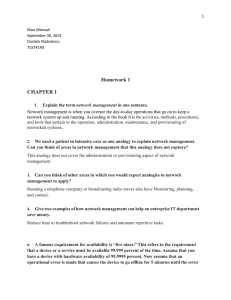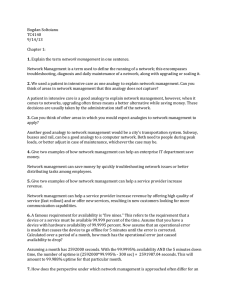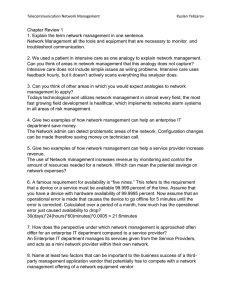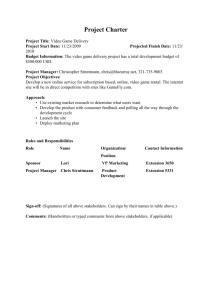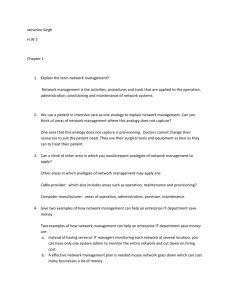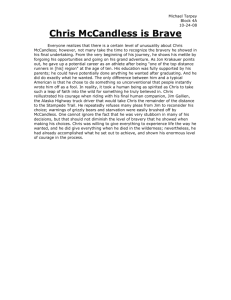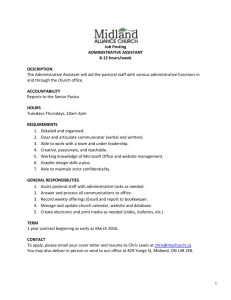TNM HW # 1 - City Tech OpenLab
advertisement
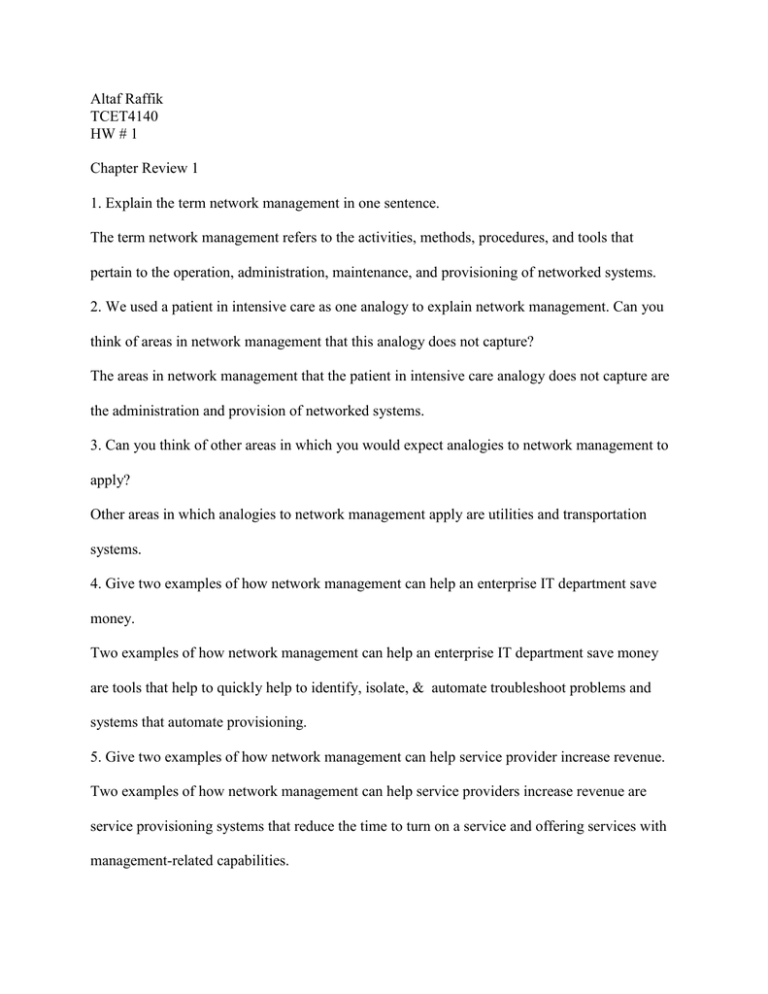
Altaf Raffik TCET4140 HW # 1 Chapter Review 1 1. Explain the term network management in one sentence. The term network management refers to the activities, methods, procedures, and tools that pertain to the operation, administration, maintenance, and provisioning of networked systems. 2. We used a patient in intensive care as one analogy to explain network management. Can you think of areas in network management that this analogy does not capture? The areas in network management that the patient in intensive care analogy does not capture are the administration and provision of networked systems. 3. Can you think of other areas in which you would expect analogies to network management to apply? Other areas in which analogies to network management apply are utilities and transportation systems. 4. Give two examples of how network management can help an enterprise IT department save money. Two examples of how network management can help an enterprise IT department save money are tools that help to quickly help to identify, isolate, & automate troubleshoot problems and systems that automate provisioning. 5. Give two examples of how network management can help service provider increase revenue. Two examples of how network management can help service providers increase revenue are service provisioning systems that reduce the time to turn on a service and offering services with management-related capabilities. 6. A famous requirement for availability is “five nines.” This refers to the requirement that a device or a service must be available 99.999 percent of the time. Assume that you have a device with hardware availability of 99.9995 percent. Now assume that an operational error is made that causes the device to go offline for 5 minutes until the error is corrected. Calculated over a period of a month, how much has the operational error just caused availability to drop? 5 𝑚𝑖𝑛 = .0115% 30 𝑑𝑎𝑦𝑠 24 ℎ𝑟𝑠 60 𝑚𝑖𝑛 × × 1 𝑚𝑜𝑛𝑡ℎ 1 𝑑𝑎𝑦 1 ℎ𝑟 7. How does the perspective under which network management is approached often differ for an enterprise IT department compared to a service provider? The perspective under which network management is approached often differs for an enterprise IT department compared to a service provider is that generating revenue and making money are not important for the enterprise department and they only have one customer the enterprise. 8. Name at least two factors that can be important to the business success of a third-party management application vendor that potentially has to compete with a network management offering of a network equipment vendor. At least two factors that can be important to the business success of a third-party management application vendor that potentially has to compete with a network management offering of a network equipment vendor are network providers management needs to operational tasks & workflows and multivendor support with the goal of being the best possible application. 9. What does the term swivel-chair syndrome refer to, and why is this undesired? The term swivel chair refers to an operator who sits in a swivel chair to move more easily between different terminals and this is undesired as the system would not be integrated in this scenario where different applications would have to be supported and managed. 10. Name two or more reasons for network management applications to be approached as distributed systems. Network management applications should be approached as distributed systems due to the fact that it must meet requirements for scale, reliability, and availability needing the managing system to be distributed itself and also that global management operations that shift the main management load can distribute and reassign processing load between servers that can be geographically distributed. Chapter Review 2 1. Is running a network only a matter of network management technology, or are there other considerations? There are other considerations in running a network other than network management technology such as the human and organizational dimensions. 2. What does Pat’s employer use to track the resolution of problems in the network? Pat’s employer uses trouble tickets to track the resolution of problems in the network. 3. How does the integration of the work order system with the trouble ticket system make Pat’s job easier? The integration of the work order system with the trouble ticket system makes Pat’s job easier as it automatically populates the fields in the work order that identify the piece of network element and location. 4. Which network provider do you think will be more vulnerable to human failures by operations personnel, Pat’s or Chris’s? Chris would be more vulnerable to human failures due to him running the entire network without as many procedures and tools as a larger network would have therefore leaving a lot of operations needed to be taken care of by him leading to a greater chance of error. 5. Which of the following can be used as management tools? A. alarm management system, B. spreadsheet, C. pencil and piece of paper, D. all of them. 6. In how many different places does Chris need to maintain the same phone number, and why could this be an issue? Chris needs to maintain the same phone number in four different places (IP PBX, voice mail system, phone number inventory, company directory). This could be an issue if the network gets larger as the procedures are not optimized and integrated. 7. When Chris is worried about compromised security of his company’s network, does the threat come from outside attackers or from within the network? The threat comes from within the network when Chris is worried about compromised security of his company’s network. 8. Connectivity between different company sites is provided by an outside MSP. Why is Chris nevertheless concerned with monitoring traffic statistics across these outside connections? Chris is concerned with monitoring traffic statistics across the outside connections provided by an outside MSP because he wants to know if they are receiving the level of services that they pay for. 9. When Sandy wants to implement a security policy for the Internet Data Center, at what different levels does she take security into account? Sandy takes security into account at the user/application and networking levels. 10. Why is Sandy interested in “old” performance data and traffic statistics, even though she is not monitoring actual network operations? Sandy is interested in “old” performance data and traffic statistics to use it to plan the network and see what requirements the network would have to fulfill.
